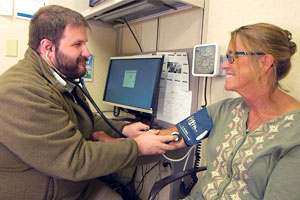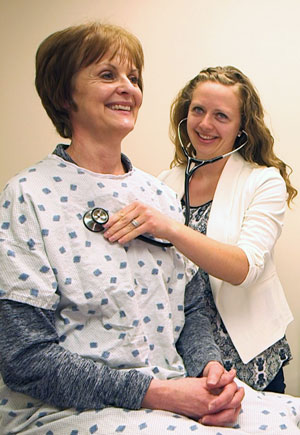Return on Investment
By Stacy Kusler on
"The University of North Dakota (UND) School of Medicine & Health Sciences (SMHS) appreciates the strong support it has received for this program from the North Dakota state Legislature," remarked Dr. Joshua Wynne, dean of the medical school and UND's interim president. "This is a big step in the right direction of meeting the healthcare workforce needs and improving the quality of life for the citizens of North Dakota, especially those in rural areas."
This is a big step in the right direction of meeting the healthcare workforce needs and improving the quality of life for the citizens of North Dakota, especially those in rural areas.
He was speaking of one of his own initiatives – the RuralMed program – designed to boost the number of physicians serving the state.
And so far, so good.
Nearing the start of its eleventh year, the RuralMed program at the UND SMHS is making its mark in North Dakota by supplying physicians to rural areas.
Students pursuing careers in family medicine, as well as the more recently added specialties of general surgery and internal medicine, will have the cost of tuition for up to four years paid for through a forgivable student loan. In return, recipients agree to practice in rural North Dakota for five years following the completion of their medical training.
The program was started with the end goal in mind – to serve the state. An additional benefit of this program is the immense debt relief it provides to participants.
"RuralMed serves a dual purpose, benefiting both our students and the people of North Dakota. Currently we have RuralMed recipients practicing in the rural communities of Devils Lake, Grafton, Mayville, Rugby, Valley City, and Williston," said Jenny Duffy, the program's manager and the associate director for medical student financial aid at UND SMHS. "The benefit to our students is extremely important as well. Student loan debt in our country has surpassed $1.5 trillion and is the highest form of consumer debt, outside of mortgages. RuralMed provides an opportunity for our students to complete medical school with significantly less debt than their peers."
The Road Less Borrowed
Is the reduction in medical school debt enough to garner interest in a five-year commitment post-training, though? Program participants Dr. Travis Waswick (2015 UND alum) and Dr. Chelsea Traverse (2013 UND alum) certainly think so.

Dr. Waswick is in his first year of practice at Sanford Health in Mayville, North Dakota. The Minot, North Dakota, native had his sights set on rural since his undergraduate years at UND when he served as an emergency medical technician for the Mayville ambulance crew. His time spent volunteering there opened his eyes to the type of community he wanted to serve in the future.
"You can make the biggest impact there [in a rural community]," he said.
The RuralMed Program allows you to practice confidently and to know you don't have an enormous mountain of debt staring at you every day.
Dr. Waswick knew rural was where he wanted to be, and when he heard about the RuralMed program, it eased his mind about paying off loans and solidified his decision to practice in rural North Dakota versus another state. "Especially in beginning a practice, there's a lot of concern about how you're going to build that practice. The RuralMed Program allows you to practice confidently and to know you don't have an enormous mountain of debt staring at you every day. You can just go and practice and know that things will be okay," he said.

Not unlike Waswick, Dr. Chelsea Traverse grew up in Munich, North Dakota, where the closest healthcare facility was 31 miles away – in Devils Lake, North Dakota. She knew she was on a path to a career in medicine since junior high. She applied for the RuralMed program at the start of her second year of medical school.
"What made me decide to apply for the RuralMed program was my interest in rural healthcare, wanting to serve the needs of the smaller community, and then just understanding the financial burden as I was going through medical school," Traverse said. "It was kind of a perfect pairing of my interests and realizing the financial needs of a person going into this career path."
Traverse is now entering her third year in practice at Sanford Health in Valley City, North Dakota. Both Traverse and Waswick say the RuralMed program has been life-changing.
This is definitely a program I'd recommend.
"This is definitely a program I'd recommend. You get so much more financial freedom. You're going to come into your practice with much less debt, and that's going to help you jump-start your life after medical school and after residency," Waswick said.
Traverse agrees. "Now that I'm in practice, I think the best thing is not worrying about loans at all," she said. "[The program] also helped me be prepared to know what job I was going into and kind of tailor my training a little bit more. Instead of [focusing on] finding a job in the second or third year of residency, I knew where I was going to work even before I started residency."
There have been 25 RuralMed recipients, ranging from students to practicing physicians, since the program began in 2009. Seven of those recipients are currently out in the workforce in rural North Dakota. This number will continue to increase as RuralMed recipients complete their residency training and begin their service commitment in rural communities throughout North Dakota.
View RuralMed Program Video
This article originally appeared in the Fall 2019 issue of North Dakota Medicine.


 is the connection between rural healthcare facilities in North Dakota and qualified health professional job seekers. As the workforce specialist, she assists rural facilities to attract medical providers and other health professionals to their communities by sharing job opportunities. Through her position, Stacy is working to reduce the healthcare workforce shortages throughout the state.
is the connection between rural healthcare facilities in North Dakota and qualified health professional job seekers. As the workforce specialist, she assists rural facilities to attract medical providers and other health professionals to their communities by sharing job opportunities. Through her position, Stacy is working to reduce the healthcare workforce shortages throughout the state.



